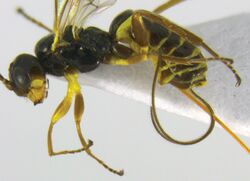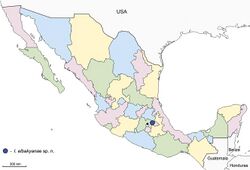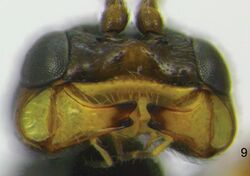Biology:Idiogramma elbakyanae
| Idiogramma elbakyanae | |
|---|---|

| |
| Female holotype (antennae, wings, and ovipositor out of frame) | |
| Scientific classification | |
| Domain: | Eukaryota |
| Kingdom: | Animalia |
| Phylum: | Arthropoda |
| Class: | Insecta |
| Order: | Hymenoptera |
| Family: | Ichneumonidae |
| Subfamily: | Tryphoninae |
| Tribe: | Idiogrammatini |
| Genus: | Idiogramma |
| Species: | I. elbakyanae
|
| Binomial name | |
| Idiogramma elbakyanae Khalaim in Khalaim & Ruíz-Cancino, 2017
| |

| |
| Distribution map, showing location where I. elbakyanae were found (⬤)[1] | |
Idiogramma elbakyanae is a species of parasitoid wasp found in the Mexican state of Tlaxcala. The species was named and described by the Russian entomologist Andrey I. Khalaim. The description was published in a 2017 open access article co-authored with Mexican entomologist Enrique Ruíz-Cancino.[1]
Etymology
Andrey I. Khalaim, an entomologist at the Russian Academy of Sciences, chose the specific name elbakyanae to honor Sci-Hub founder Alexandra Elbakyan "in recognition of her contribution to making scientific knowledge available for all researchers".[1] Elbakyan took offense to being the namesake of a "parasitic insect"; this in part led to her temporary shutdown of Sci-Hub in Russia.[2] In a message which appeared when Russians attempted to visit Sci-Hub, she said that it was an "extreme injustice"[lower-alpha 1] to have the wasp named after her.[3][4] Khalaim was surprised by her reaction, emphasizing he intended it to be an honor. He said he approves of Sci-Hub[5] and regularly uses it himself.[6] He also clarified that, as parasitoids kill their hosts, it should be more thought of as a predatory wasp, than a parasite.[7]
Taxonomic history
The type series comprised a female holotype and four male paratypes, all collected in 2016.[1] The holotype and one paratype were deposited at National Autonomous University of Mexico; the other three paratypes were deposited at the Autonomous University of Tamaulipas, the Zoological Museum of the Zoological Institute of the Russian Academy of Sciences, and the Natural History Museum, London.[1]
Distribution
It is found in the central Mexican state of Tlaxcala. The type locality, where all specimens in the type series were found, is in Nanacamilpa de Mariano Arista.[1] The specimens were all caught in forest of pine and oak trees; the collection site was at an elevation of 2,830–2,900 metres (9,280–9,510 ft).[1]
Description
I. elbakyanae can be distinguished from the only other Idiogramma species in Mexico, I. comstockii, in having a black or yellowish-brown face, a mandible which is significantly broader at its basal end than its apical end, and an ovipositor sheath which is 4.2 times the length of its hind tibia.[1]
The female has a body length of 3.8 mm (0.15 in) and a forewing length of 3.9 mm (0.15 in).[1]
Notes
- ↑ Elbakyan's original Russian text: "А недавно сотрудник Российской академии наук решил назвать в честь Александры паразитическое насекомое (речь идет о насекомых из семейства наездников-паразитов). Что я рассматриваю как крайнюю несправедливость: ведь если анализировать ситуацию с научными публикациями, то настоящими паразитами являются научные издательства, а Sci-Hub, наоборот, борется за равный доступ к научной информации и делает полезное дело."[8][9]
References
- ↑ 1.0 1.1 1.2 1.3 1.4 1.5 1.6 1.7 1.8 Khalaim, Andrey I.; Ruíz-Cancino, Enrique (31 August 2017). "Ichneumonidae (Hymenoptera) associated with xyelid sawflies (Hymenoptera, Xyelidae) in Mexico". Journal of Hymenoptera Research 58: 17–27. doi:10.3897/jhr.58.12919.
- ↑ "Sci-Hub briefly shutters". Science 357 (6356): 1079–1080. 2017. doi:10.1126/science.357.6356.1078.
- ↑ "Сервис Sci-Hub прекратил свою работу на территории России". Rambler&Co. 5 September 2017. https://indicator.ru/news/2017/09/05/sci-hub/. Retrieved 28 November 2017.
- ↑ Cragg, Oliver (6 September 2017). "Sci-Hub facing $4.8m piracy payout as site shut down in Russia over 'liberal opposition'" (in en). http://www.ibtimes.co.uk/sci-hub-facing-4-8m-piracy-payout-site-shut-down-russia-over-liberal-opposition-1638251. Retrieved 28 November 2017.
- ↑ Котляр, Павел (5 September 2017). ""Варитесь в своем дерьме сами"". Rambler&Co. https://www.gazeta.ru/science/2017/09/05_a_10875050.shtml. Retrieved 29 November 2017.
- ↑ Chawla, Dalmeet Singh (7 September 2017). "American Chemical Society demands $4.8 million in damages from Sci-Hub" (in en). Royal Society of Chemistry. https://www.chemistryworld.com/news/american-chemical-society-demands-48-million-in-damages-from-sci-hub/3007960.article. Retrieved 29 November 2017.
- ↑ Sivtsova, Alexandra (6 September 2017). "The 'Edward Snowden' of pirated scholarly literature has banned Russian Internet users because of a personal grudge — Meduza". Meduza. https://meduza.io/en/feature/2017/09/07/the-edward-snowden-of-pirated-scholarly-literature-has-banned-russian-internet-users-because-of-a-personal-grudge. Retrieved 28 November 2017.
- ↑ McLaughlin, Steve [@SteveMcLaugh] (5 September 2017). "Alexandra Elbakyan just blocked all of Russia from accessing Sci-Hub. Here's the message that pops up: original & translated by Google.". https://twitter.com/SteveMcLaugh/status/905081868478971908.
- ↑ Сивцова, Александра (6 September 2017). "Именем создателя бесплатной базы научных публикаций назвали насекомое. Она пожаловалась на травлю и заблокировала сайт для ученых из России". Meduza. https://meduza.io/feature/2017/09/06/imenem-sozdatelya-besplatnoy-bazy-nauchnyh-publikatsiy-nazvali-nasekomoe-ona-pozhalovalas-na-travlyu-i-zablokirovala-sayt-dlya-uchenyh-iz-rossii. Retrieved 28 November 2017.
Wikidata ☰ Q38687253 entry
 |


